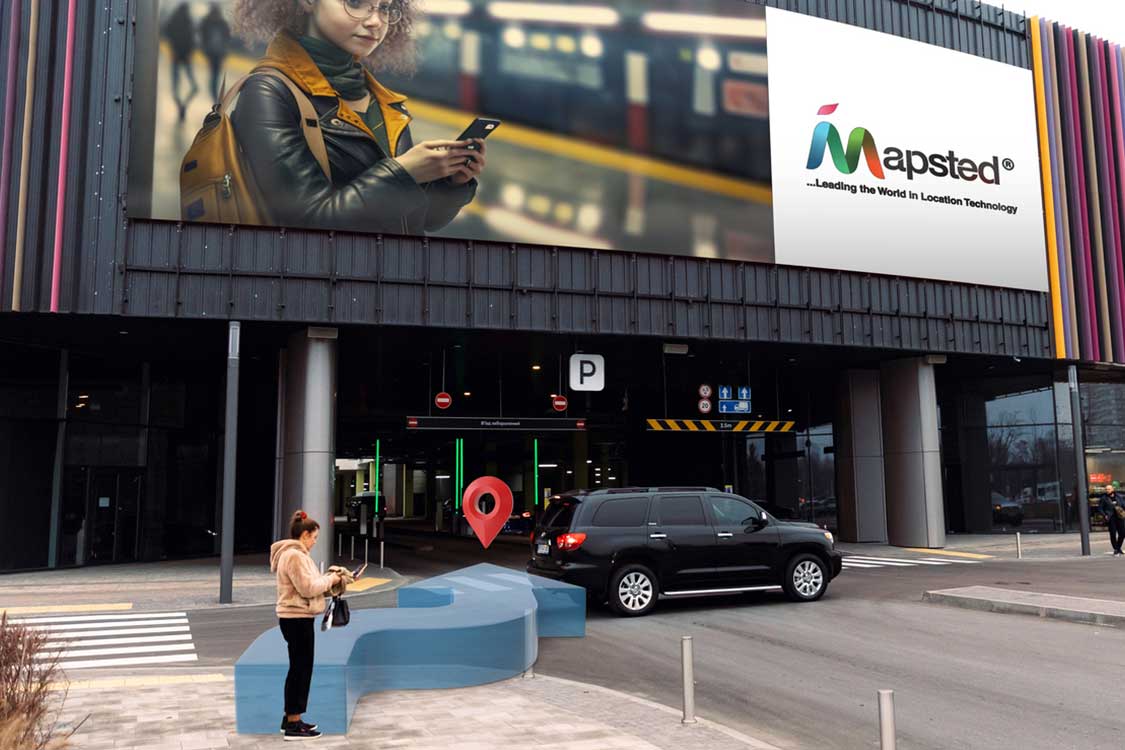Technology Trends

Whether inside a large building or on a sprawling campus with multiple buildings spread across hectares, more businesses and organizations are ditching traditional maps in favour of digital wayfinding technology solutions to make navigating physical spaces easier. With just a few taps, users can easily know where they are, where they want to go and how to get there. Google and Apple Maps are classic wayfinding system examples that use GPS.
These solutions work well outdoors, but indoors they are unreliable and inconsistent. Indoor digital wayfinding technology and interactive wayfinding solutions are simplifying indoor navigation and establishing themselves as the future of wayfinding, making digital wayfinding synonymous with intelligent indoor navigation. Here’s how this technology works and the benefits it offers.
What is Digital Wayfinding Technology?
Digital wayfinding technology uses virtual tools in a physical environment to provide directions and navigational prompts via digital wayfinding kiosks and smartphones. When combined with indoor positioning technology, users can search for their desired destination and get turn-by-turn directions.


While many indoor positioning systems require expensive external hardware and costly maintenance fees, the future of wayfinding has arrived with innovative location technology solutions such Mapsted‘s interactive digital wayfinding platform. It requires no traditional hardware such as Bluetooth beacons installed throughout your premises to enable seamless indoor-outdoor navigation. Mapsted’s proprietary, hardware-free location technology adjusts orientation and creates contextual navigation based on the user’s real-time position using AI and machine learning. In complex indoor layouts, positioning is precise to within 1-5 metres.
Digital Wayfinding Examples
If you prefer self-help, digital wayfinding software for kiosks as well as mobile phone apps is the way to go. Large venues, such as hospitals, shopping malls, universities and corporate offices are ideal places to deploy interactive wayfinding technology. It helps guests, visitors, maintenance personnel and even workers to determine where they are and where they need to be. Kiosk-based digital wayfinding informs people about points of interest and the shortest route to their destination.
The adaptability of interactive wayfinding solutions contributes to their popularity. For example, freestanding kiosks and large wall-mounted displays are ideal for conveying generic information to all types of visitors. However, extending digital wayfinding features to personal devices such as tablets and mobile phones allows for more personalized.
What Should Interactive Wayfinding Systems Do?
A wayfinding system is a stand-alone solution or an interface that allows users to search for and navigate to indoor destinations in real time. This reduces stress while also gathering the spatial information needed to quickly adapt to the physical space. While navigating on an interactive wayfinding app, visual markers, lines and arrows instill confidence, allowing users to adapt to their surroundings in the same way that they adapt to road signs. A wayfinding solution’s purpose is not only to lead users between two destinations but also to help build a sense of familiarity in an instant.
Where Can Digital Wayfinding Be Used?
Because of its tremendous potential, digital wayfinding technology is becoming more common in commercial and non-commercial spaces. It’s no secret that directional assist technologies impact business bottom lines and delight workers and consumers alike in every stride. Here is a small selection of the industries where digital wayfinding technology has produced impressive results:
Higher Education Facilities
For large sprawling campuses spread across hectares, such as University of Windsor, a friendly blue-dot navigator will prove invaluable to visitors, staff, and students. New students and visitors, in particular, who are unfamiliar with the campus’s long corridors and paths will benefit from the navigation app.
Transportation Hubs
Short layovers at airports increase stress levels. Large airports, such as Miami International Airport, are multi-terminal structures with intricate pathways leading to various points of interest. Without a wayfinding solution, first-time air travelers are more likely to miss their onward flights. A digital wayfinding technology app, such as Mapsted, can reduce traveler stress and make terminal hopping a breeze.
Healthcare Facilities
Like airports, large hospitals have multiple wings that are tricky to navigate without location assistance technology. A digital wayfinding technology solution is extremely useful in this situation because it improves patient convenience. It saves time spent looking for consultation rooms during peak hours and in contingencies. Patients are not the only ones who benefit directly from wayfinding technology. Even caregivers find the technology useful in moments of need. Hospitals can always be prepared for emergencies with a comprehensive floor map that includes the location of medical equipment.
Retail Shopping Malls
First-time visitors and even regular shoppers may find themselves overwhelmed by the sheer size and complexity of mall structures. Digital wayfinding technology in a mall could ease locating shops, cafés, and services within the structure. It creates a sense of familiarity, allowing people to arrive at their desired spot without feeling stressed. A mall that is easy to navigate will also improve the visitor experience and inspire them to return.
Corporate Offices
Many corporations across the globe have massive bases with thousands of employees. Navigating such premises can waste valuable work time, and new employees are frequently lost in complex pathways snaking through the facility, missing meetings and not being as productive as they could be. In addition, implementation of a digital wayfinding technology solution can provide contractors and maintenance personnel direct navigation to their task sites while ensuring they don’t enter high-security areas.
Benefits of Digital Wayfinding
Reliability
Using digital wayfinding technology ensures that users have access to up-to-date information. A digital map can be updated regularly to reflect changes in the environment and tailored to your branding details. Changing the interiors of rooms, moving furniture and other objects will appear as they are on the map, ensuring that navigation data is calibrated for workers, customers and other users.
Enhanced Efficiency
By cleaning up the view, users can see relevant data that is organized and easy to follow. When data is self-explanatory, navigation is intuitive and requires no hand-holding. It frees up essential staff from front-desk roles, allowing them to focus on more productive tasks. Improving efficiency also allows for greater cost savings and meeting user expectations.
Personalized and Minimalist
Innovative digital wayfinding tech is more minimalist and integrates into the user’s journey. When compared to large centerpiece physical installations, interactive wayfinding kiosks and personalized navigation assistance on mobile phones is streamlined and modern.
Self-Reliant Journeys
The information on the digital wayfinding system is simple to use. It poses little difficulty to new users because the information is customized to individual preferences. Whether it’s language options or accessibility support, the solution has features for all types of audiences so they can navigate without contacting support.
Conclusion
Indoor wayfinding technology has become more common across industries and consumer segments. Consumers are increasingly willing to switch to a system that makes their journey intuitive and personalized. Whether on campus, in shopping malls, universities, or offices, the ability to navigate untethered is as important as finding information that will enhance their experience within a venue. Mapsted can help you achieve your digital wayfinding goals and so much more.
If you enjoyed this blog you will want to check out our blog on What Is Blue-Dot Navigation and How Can It Benefit Your Business? and watch our quick video to Explore Mapsted’s Location Based Technology Solutions for Forward-Thinking Businesses.
Frequently Asked Questions
Q1. What is digital wayfinding technology?
Ans. Digital wayfinding technology uses virtual tools in a physical environment to provide directions and navigational prompts via digital wayfinding kiosks and smartphones. When combined with indoor positioning technology, users can search for their desired destination and get turn-by-turn directions.
Q2. What are the benefits of digital wayfinding technologies compared to traditional mapping solutions?
Ans. Digital wayfinding technologies are beneficial compared to traditional mapping solutions because they are more reliable, efficient, are more environmentally friendly and promote self-reliant journeys.
Q3. What is the best digital wayfinding technology?
Ans. While many indoor positioning systems require expensive external hardware and costly maintenance fees, the future of wayfinding has arrived with innovative location technology solutions such Mapsted‘s interactive digital wayfinding platform. It requires no traditional hardware such as Bluetooth beacons installed throughout your premises to enable seamless indoor-outdoor navigation. Mapsted’s proprietary, hardware-free location technology adjusts orientation and creates contextual navigation based on the user’s real-time position using AI and machine learning. In complex indoor layouts, positioning is precise to within 1-5 metres.
Q4. Where Can Digital Wayfinding Technology Be Used?
Ans. Wayfinding technologies can be deployed in any indoor or indoor/outdoor environment quickly and easily, and can be seamlessly scaled to any size space with multiple levels, buildings and elevations.
Q5. How is Digital Wayfinding Technology different from Google Maps and Apple Maps?
Ans. Google and Apple Maps are classic wayfinding system examples that use GPS. These solutions work well outdoors, but indoors they are unreliable and inconsistent. Indoor digital wayfindng technology and interactive wayfinding solutions simplify indoor navigation are configured specifically for challenging indoor environments to produce accurate and precise results.
